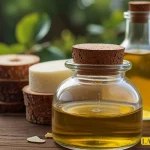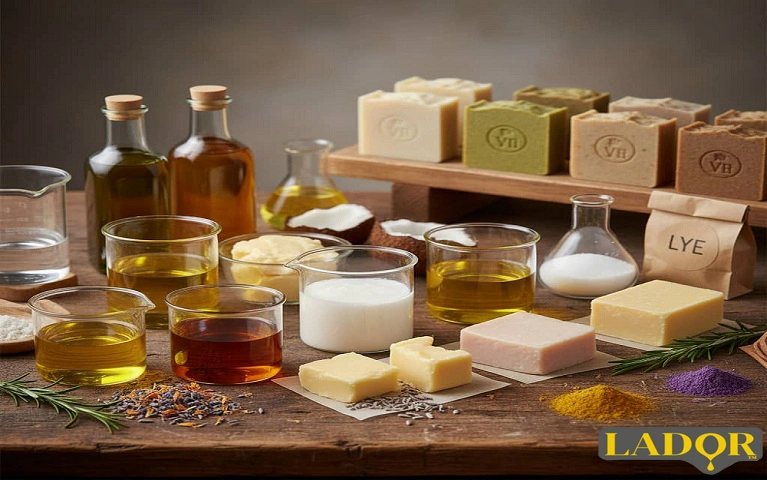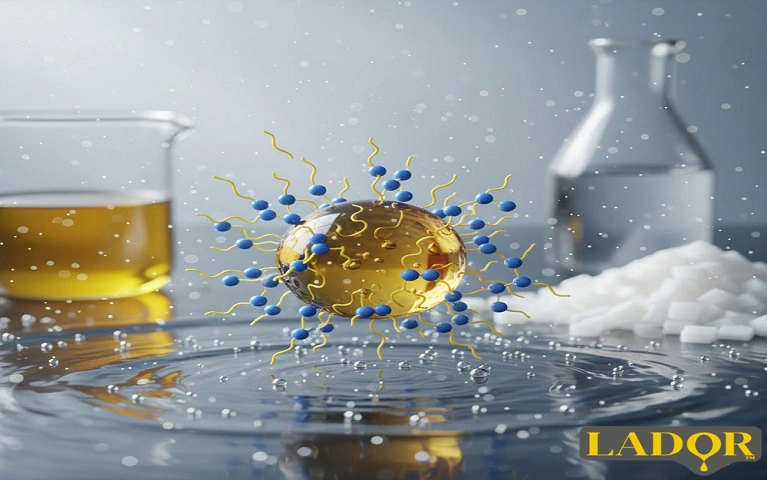

Fats in soap making are very important and are made up of triglycerides.Triglycerides are esters formed by the connection of three fatty acid molecules to one glycerol molecule. The type and carbon chain length of these fatty acids play a key role in determining the properties of the final soap (such as hardness, lathering ability, and mildness). Tallow fatty acid is one of these fatty acids. Join us in the continuation of this article from Ladorfat to examine the fats used in soap making.
Soaps have been used as one of the most essential cleaning agents by humans since ancient times, with their production dating back thousands of years. Chemically, soaps are the sodium or potassium salts of long-chain fatty acids. The soap molecule has a dual nature; a polar and hydrophilic head that dissolves in water, and a nonpolar and lipophilic (hydrocarbon) tail that dissolves in fats and oils. This dual structure allows soap to bridge the gap between water and oil, separating oily dirt from surfaces and suspending it in water as an emulsion.
Soap production is carried out through a chemical reaction called saponification. In this process, fats or oils (triglycerides) react with a strong alkaline substance (such as sodium hydroxide or potassium hydroxide).
General Equation for the Saponification Reaction:
Fat/Oil (Triglyceride)+Alkali (Sodium/Potassium Hydroxide)→Soap (Fatty Acid Salt)+Glycerol (Glycerin)
Various fats and oils are used in soap formulation, each imparting unique properties to the final product. These fats are often selected based on the composition of the fatty acids they contain.
Palm oil and Beef tallow oil (cow tallow) contain high amounts of long-chain fatty acids such as oleic acid (C18, unsaturated), palmitic acid (C16, saturated), and stearic acid (C18, saturated). Soaps containing these acids (such as sodium stearate) are generally hard, dissolve slowly, and are mild, producing less lather, which is often a creamy and stable foam. Olive oil is also specifically used in Castile soaps due to its mildness and moisturizing properties.
Coconut oil and palm kernel oil are both rich in short and medium-chain fatty acids, especially lauric acid (C12) and myristic acid (C14). The resulting soaps, due to the presence of sodium laurate, produce a copious and thick lather even in cold and hard water. However, excessive use of these oils can lead to a soap that is hard and drying to the skin.

Soap formulation involves the precise selection of the ratio of fats and oils, the type and amount of alkali, and additives to achieve the desired properties.
The soap making formula is determined based on the saponification value (the amount of alkali required to completely saponify one gram of fat) of each oil. To produce a balanced soap, a mixture of fats with different properties is usually used. For example, a combination of coconut oil (for copious lather) and palm oil or tallow (for hardness and mild lather) is common.
One of the important points in soap formulation is the process of superfatting. This means using a small amount of extra fat that is deliberately left unreacted in the saponification process. This extra fat (typically 5 to 10 percent) acts as an emollient and moisturizer, reducing the soap’s dryness and alkalinity, which is crucial for sensitive skin.
Soap production methods can be divided into two general categories: industrial and artisanal processes:
This method is mostly used in the production of handmade soaps. The saponification reaction is carried out without the use of external heat, relying only on the heat generated by the reaction itself (exothermic) to complete the process. The soap must remain in the mold for several weeks (the curing period) for the reaction to fully complete and for the water to evaporate. In this method, glycerin naturally remains in the soap.
In the hot process and industrial production processes, external heat is used to accelerate and complete the saponification reaction. In the industrial method, salt is often used to separate the soap from the glycerin and excess alkali (a process called salting out). Separating the glycerin leads to a purer soap and allows for the recovery of glycerin (a valuable byproduct) for use in other products like lotions.
As mentioned, the cleaning ability of soap is due to the presence of both the hydrophilic and lipophilic parts. The lipophilic tail of the soap surrounds the fat and dirt particles, forming a structure called a micelle. The hydrophilic head of the micelle is suspended in water, allowing the fat to be washed away with the water. The shorter the fat chain length (like lauric acid), the greater the lathering and the better the solubility in water.
One of the most significant challenges related to soap fat is its performance in hard water. Hard water contains a high concentration of metallic ions (such as calcium Ca2+ and magnesium Mg2+). In the presence of these ions, the sodium salts of the fatty acids (soap) react with them to form insoluble calcium and magnesium soaps. These insoluble compounds precipitate as scum or cloudiness on surfaces (like tiles or hair) and reduce the cleaning efficacy of the soap.

Ala oil Sepahan Company, with the commercial brand Lador, is one of the active producers of industrial fats and oils, as well as raw materials and additives for livestock and poultry feed production in Iran. The diversity in Ladorfat Company’s products demonstrates its ability to separate and process various fatty components, including for non-food applications like soap making. The company plays an important role in supplying raw materials for domestic producers of soap and related products.
Ladorfat Company produces various animal fats, including Tallow Oil and Bone Oil. These fats are important sources of long-chain fatty acids such as stearic and palmitic acids.
Tallow oil is traditionally one of the most widely used raw materials in soap making, grease manufacturing, chemical industries, and more. Tallow is used in soap formulation for the production of hard and durable industrial soaps due to its hardness and stability. The production of these fats, which are often byproducts of meat processing, highlights the company’s role in the supply chain of fatty materials for industries such as soap making, lubricants, and animal feed.
Soap fat is the beating heart of the soap making industry. The selection of the type of fat (whether animal or vegetable), based on its fatty acid composition, directly impacts the final soap properties, including lathering, hardness, and moisturizing effects. The saponification process converts the chemical nature of triglyceride fats into cleaning salts, yielding the valuable byproduct, glycerin. Finally, the activity of companies like Ala oil Sepahan in the production and processing of industrial and animal fats plays a vital role in supplying the raw materials for this ancient, yet modern, industry. To inquire about prices and receive information, you can contact our consultants at Ladorfat. Thank you for staying with us until the end of the article.